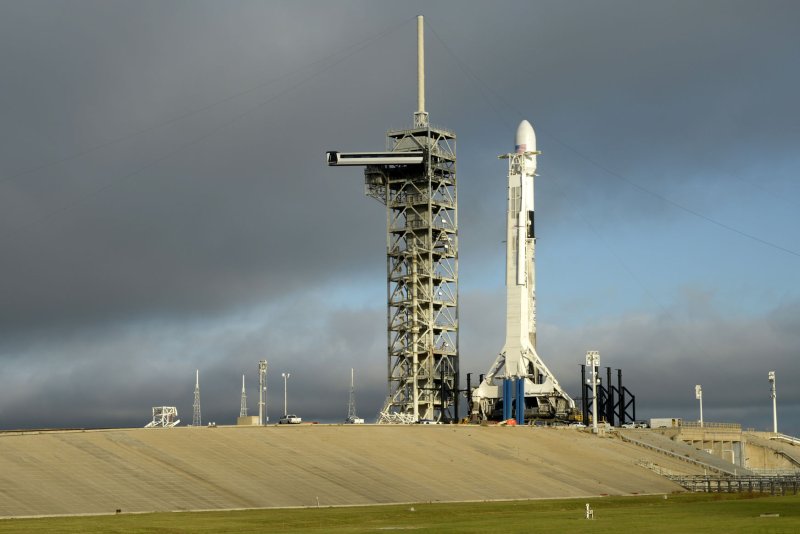On Dec. 4, SpaceX will launch more than 20 experiments as part of a resupply mission to the International Space Station. SpaceX last launched a Falcon 9 rocket on Nov. 4, pictured ahead of the launch, to deliver the Es'hail Communications Satellite into orbit for the country of Qatar. Photo by Joe Marino-Bill Cantrell/UPI |
License Photo
Nov. 28 (UPI) -- The newest space station resupply mission, SpaceX CRS-16, features a diversity of science experiments organized by the International Space Station U.S. National Laboratory.
SpaceX's Dragon capsule is scheduled to be carried into space by the company's Falcon 9 rocket on Dec. 4. The rocket and payload will launch from Space Launch Complex 40 at Cape Canaveral Air Force Station in Florida.
"[CRS-16] is absolutely packed with research," Patrick O'Neill, spokesperson for the ISS National Lab, told UPI.
Experiments on the SpaceX payload involve a variety of scientific fields, including genomics, cellular biology, botany, immunology and more.
Evaluators at the ISS National Lab work with NASA and a variety other federal agencies, including the Department of Agriculture and National Institutes of Health, to select scientific experiments that could benefit from the space station's microgravity environment.
ISS National Lab fields investigations proposed by researchers from a variety of institutions, including public universities, major corporations, startups and more.
One of the experiments traveling to the space station on the forthcoming resupply mission is a tissue chip project designed by Sonja Schrepfer, a researcher from the University of California, San Francisco. Schrepfer's investigation aims to measure the impacts of microgravity on the human immune system.
NIH has worked with ISS National Lab to secure space for several tissue chip projects.
"The chip experiments feature small microscope sized devices, slides measuring 1 by 3 inches or so, that can be populated with different human cell types," Michael S. Roberts, deputy chief scientist at ISS National Lab, told UPI. "If you create the right environment and feed the cells the right stuff, you can guide them into behaving like specific human tissues and even whole organs."
It's much simpler, cheaper and more efficient to study small tissue samples than entire organs.
"They're a great interest to a pharmaceutical sector because they would make it much easier for drug makers and researchers to test the effect of drugs on different tissue types and organs," Roberts said.
Accompanying the tissue chip project is an experiment designed to test the efficacy of a wound-healing technology developed by Elaine Horn-Ranney and her biomedical company Tympanogen. The space station's microgravity environment will allow Horn-Ranney to precisely measure the ability of her novel hydrogel to promote healing and fend off infection-causing bacteria.
Microgravity is ideal for studying the properties of very thin layers.
"In normal environs here on Earth, when you're laying down a very thin layer of something, heterogeneity in the mixture of materials is inevitable," Roberts said. "There will be different densities involved, and as a result, potential defects. In the absence of gravity, you don't have convection currents within the material, so you have more homogeneity across the layer, and thus, more reliable experimental results."
An experiment designed by Budweiser is also flying to ISS aboard the SpaceX cargo ship. The experiment will test the effects of microgravity on steeping, germination and kilning, processes involved in malting barley. The results could help beer makers design barley varieties capable of withstanding more stressful growing conditions.
Microgravity is also an ideal environment for studying biomedical devices like implants. An experiment designed by Nicole L. Wagner, a researcher at LambdaVision, will help scientists better understand how protein-based retinal implants grow and form different shapes.
"Under microgravity, biomaterials are able to perform more like they would inside the body," Roberts said. "In the body, biological materials aren't in contact with cells all the time. Many times they're free floating."
All of the experiments traveling to the International Space Station next week were evaluated for their scientific potential.
"We look at whether a research project will have both tangible and intangible impacts," Roberts said. "We're looking not only at the experiment's benefit to a single company but it's benefit to humankind upon its return to Earth."















